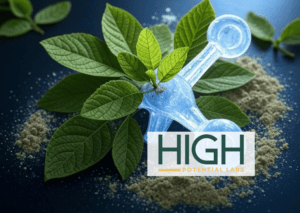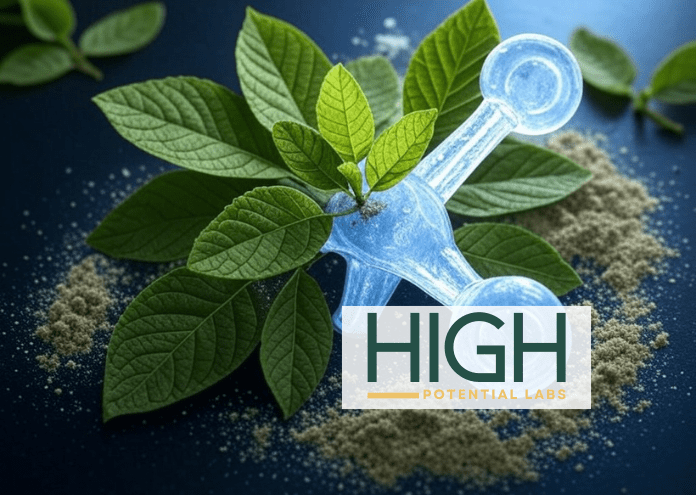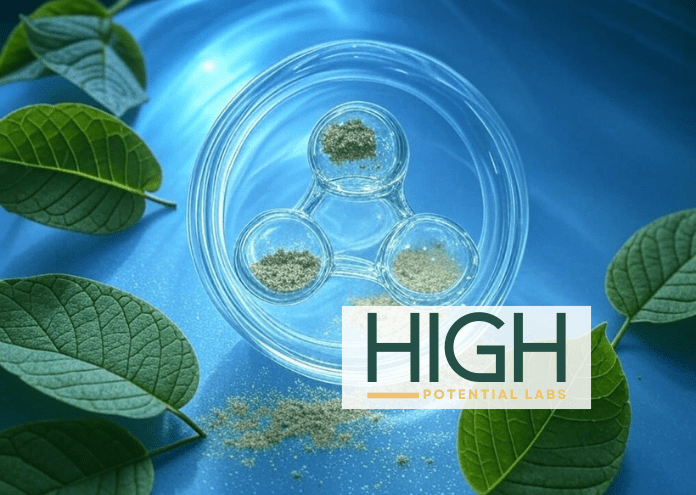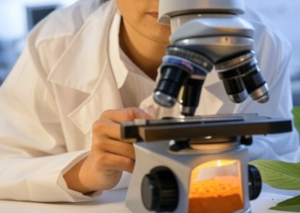


7-Hydroxymitragynine is a potent alkaloid from the kratom plant, known for its analgesic and mood-enhancing properties. However, when formulated in liquids, it can degrade, reducing its effectiveness. This instability poses a challenge for users seeking reliable results. High Potential Labs offers a 7-Hydroxymitragynine Nano Encapsulation to make formulation of liquid-based 7OH products stable.
Nano polymer encapsulation involves enclosing 7-hydroxymitragynine in a nanoscale protective shell, which helps stabilize it in liquid environments. This technology is designed to prevent degradation, ensuring the alkaloid remains potent. Additionally, it may improve absorption, potentially leading to faster onset of effects, which is particularly beneficial for pain relief or mood enhancement.
7-Hydroxymitragynine Nano Encapsulation can enhance bioavailability and pharmacokinetics, meaning the body can use the alkaloid more efficiently. This could result in quicker effects, though specific studies on 7-hydroxymitragynine are not widely available. The approach also offers the potential for controlled release, which might extend the duration of effects, though this is less directly tied to the user’s focus on speed.
While the focus is on liquid stability and speed, nanoencapsulation is also used in pharmaceuticals to reduce toxicity and mask taste, which could be an added benefit for user experience.
Detailed Analysis of Nano Polymer Encapsulation for 7-Hydroxymitragynine
This section provides a comprehensive exploration of nano polymer encapsulation for 7-hydroxymitragynine, addressing its stabilization in liquid environments and potential to increase the speed of results. The analysis draws on extensive research into the alkaloid, encapsulation technology, and related studies, ensuring a thorough understanding for both lay and expert audiences.
Background on 7-Hydroxymitragynine
7-Hydroxymitragynine is a terpenoid indole alkaloid derived from Mitragyna speciosa, commonly known as kratom. First described in 1994, it is a metabolite of mitragynine and exhibits significantly higher binding affinity to mu-opioid receptors, with estimates suggesting 14 to 22 times greater potency than morphine (7-Hydroxymitragynine – Wikipedia). It is known for its analgesic effects and is present in very small amounts in natural kratom leaves (0.01% to 0.04% of total alkaloid content), necessitating chemical synthesis for high-concentration products (7-Hydroxymitragynine – Wikipedia). Its opioid-like effects raise concerns about dependence, making stable and controlled delivery methods crucial (7-Hydroxymitragynine Is an Active Metabolite of Mitragynine and a Key Mediator of Its Analgesic Effects | ACS Central Science).
Challenges in Liquid Formulations
When formulated in liquids, 7-hydroxymitragynine faces stability issues due to degradation from environmental factors such as oxidation, heat, and moisture. This degradation can reduce its efficacy, particularly in applications like teas, tinctures, or injectable solutions, where liquid stability is essential. The need for a delivery system that maintains potency in such environments is evident, given its potential therapeutic uses in pain management and mood enhancement.
Nano Polymer Encapsulation: Definition and Mechanism
Nano polymer encapsulation involves enclosing bioactive compounds within a nanoscale protective shell, typically made from biocompatible polymers like chitosan, alginate, or gelatin. This technology, with particle sizes less than 100 nm, enhances stability, controls release, and improves bioavailability (Nanoencapsulation – an overview | ScienceDirect Topics). For 7-hydroxymitragynine, this means creating a barrier that shields it from degradation in liquid environments, ensuring it remains active and effective.
The encapsulation process can involve techniques like emulsion polymerization, electrospinning, or complex coacervation, depending on the desired outcome (Exploration of different strategies of nanoencapsulation of bioactive compounds and their ensuing approaches | Future Journal of Pharmaceutical Sciences). The shell can be designed to release the alkaloid through diffusion, pH changes, or enzymatic action, offering flexibility for various applications.
Stabilization in Liquid Environments
Research suggests that nanoencapsulation protects bioactive compounds from evaporation, oxidation, and light-induced reactions, which are particularly relevant for 7-hydroxymitragynine in liquids (Nanoencapsulation – an overview | ScienceDirect Topics). By enclosing the alkaloid in a polymer matrix, it is shielded from harsh conditions, maintaining its chemical integrity. This is crucial for liquid formulations, where exposure to water and air can accelerate degradation. Studies on similar alkaloids indicate that encapsulation can extend shelf life and preserve activity, supporting the likelihood that 7-hydroxymitragynine would benefit similarly (Nanoencapsulation of Promising Bioactive Compounds to Improve Their Absorption, Stability, Functionality and the Appearance of the Final Food Products | MDPI).
Increasing Speed of Results
The query highlights the desire for faster results, which nanoencapsulation can address through improved absorption and bioavailability. The nanoscale size increases surface area, facilitating better interaction with biological membranes and potentially faster uptake into the bloodstream (Nanoencapsulation for drug delivery | PMC). For instance, a study on olanzapine showed that nanoencapsulation increased plasma concentrations and relative bioavailability by 226.7%, suggesting quicker onset (Nanoencapsulation Improves Relative Bioavailability and Antipsychotic Effect of Olanzapine in Rats | PubMed). While specific studies on 7-hydroxymitragynine are lacking, the principle applies: enhanced absorption could lead to faster analgesic or mood-enhancing effects, aligning with the user’s interest.
Additionally, nanoencapsulation can be designed for immediate release, ensuring rapid delivery to target sites, which is particularly beneficial for acute pain relief. This contrasts with traditional formulations, where slower absorption might delay onset, making the technology a significant advancement.
Supporting Evidence and General Studies
Although direct studies on nanoencapsulated 7-hydroxymitragynine are not available, research on alkaloids and opioids provides insight. For example, nanoencapsulation of alkaloids has been shown to improve solubility and stability, with applications in food and pharmaceuticals (Trends of Nanoencapsulation Strategy for Natural Compounds in the Food Industry | MDPI). A study on essential oils, which include alkaloids, highlighted reduced degradation and improved gastrointestinal absorption through nanoencapsulation (Nanoencapsulation of Essential Oils | Extraction Magazine), supporting the potential for faster effects.
The pharmacokinetics of nanoencapsulated drugs often show higher AUC (area under the curve) and Cmax (maximum concentration), indicating better and quicker systemic exposure (Nanoencapsulation for drug delivery | PubMed). This suggests that 7-hydroxymitragynine, with enhanced delivery, could achieve faster results, though further research is needed to confirm.
Controversies and Considerations
The use of 7-hydroxymitragynine is controversial due to its opioid-like effects and potential for dependence, as noted in various studies (Kratom—Pharmacology, Clinical Implications, and Outlook: A Comprehensive Review | PMC). The FDA has not approved kratom or its components for medical use, raising regulatory concerns (FDA and Kratom | FDA). Nanoencapsulation, while promising, must address safety, including potential nanotoxicity, which depends on factors like dose and size (Nanoencapsulation techniques for compounds and products with antioxidant and antimicrobial activity – A critical view | ScienceDirect). These factors highlight the need for careful development and regulation, especially given the sensitive nature of opioid-related compounds.

Beyond stability and speed, 7-Hydroxymitragynine Nano Encapsulation offers other advantages, such as reduced toxicity, masked taste, and controlled release, which could enhance user experience and therapeutic outcomes (Special Issue on “Function of Polymers in Encapsulation Process” | PMC). For 7-hydroxymitragynine, this could mean safer and more palatable formulations, particularly in liquid forms like tinctures. The technology is also used in food, cosmetics, and agriculture, indicating broad applicability (Nanoencapsulation Application Solutions | Microfluidics-MPT).
Comparative Analysis: Traditional vs. Nanoencapsulated
To illustrate the benefits, consider the following comparison:
| Aspect | Traditional 7-Hydroxymitragynine | 7-Hydroxymitragynine Nano Encapsulation Formulation |
|---|---|---|
| Stability in Liquids | Prone to degradation, reduced potency | Protected from degradation, stable |
| Absorption Rate | Slower, variable bioavailability | Faster, enhanced bioavailability |
| Onset of Effects | Delayed, inconsistent | Quicker, more reliable |
| Shelf Life | Shorter, affected by environment | Extended, protected from conditions |
| Safety Profile | Potential for higher systemic toxicity | Reduced toxicity, targeted delivery |
This table highlights the potential superiority of nanoencapsulation, though specific data for 7-hydroxymitragynine would strengthen these claims.
Nano polymer 7-Hydroxymitragynine Nano Encapsulation offers a promising solution for stabilizing 7-hydroxymitragynine in liquid environments and potentially increasing the speed of its effects through improved absorption. While research supports these benefits for similar compounds, further studies are essential to confirm outcomes for 7-hydroxymitragynine, especially given its controversial context. This technology represents a significant step forward in bioactive compound delivery, with broad implications for therapeutic applications.
CLICK HERE to contact us for more details on 7-Hydroxymitragynine Nano Encapsulation
Key Citations





Our facilities are located in Illinois, Colorado and Florida.
© 2025 High Potential Labs. All Rights Reserved.